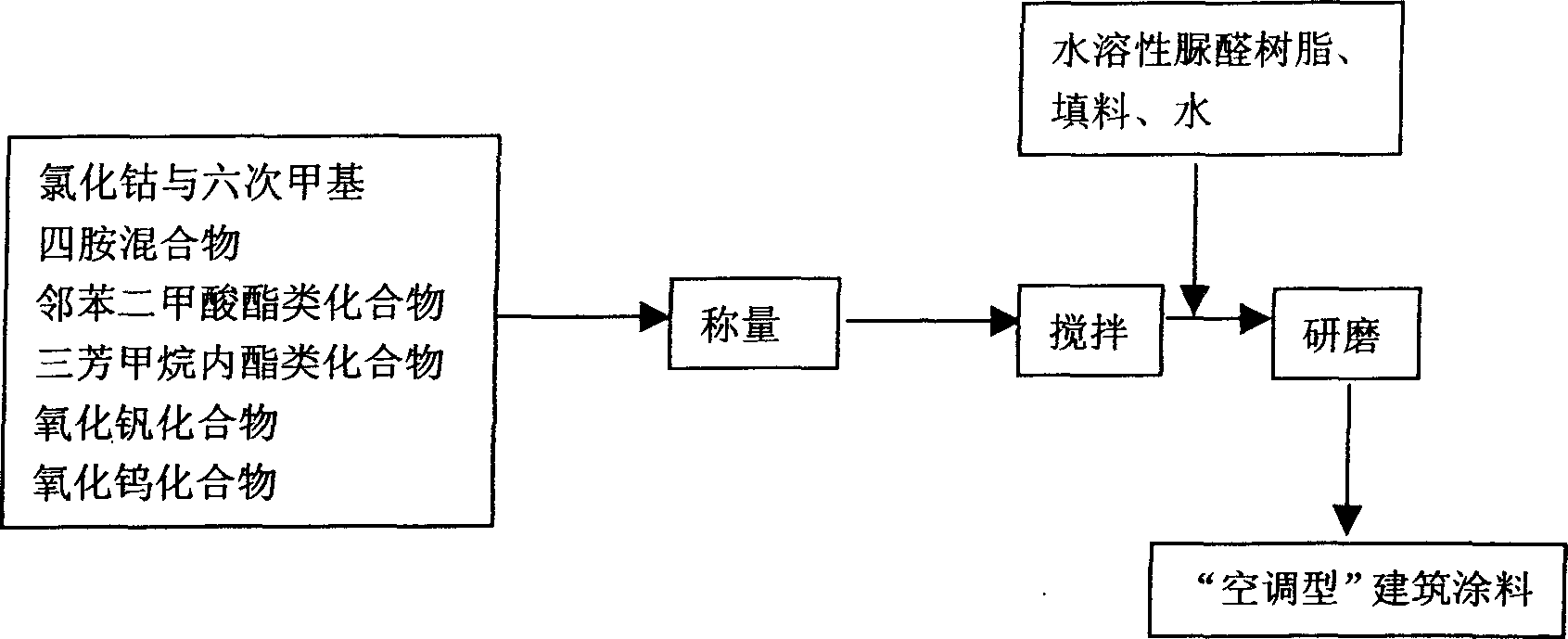'Air conditioning' building paint
An architectural coating and air-conditioning technology, applied in coatings and other directions, can solve problems such as inability to apply buildings, air and environmental pollution, complex device structure, etc., to reduce environmental pollution and greenhouse effect, large economic and social benefits, Easy to promote the effect of the application
- Summary
- Abstract
- Description
- Claims
- Application Information
AI Technical Summary
Problems solved by technology
Method used
Image
Examples
Embodiment 1
[0021] Using 7% methyl phthalate, 12% triaryl methane betaine, 3% vanadium oxide and 78% water-soluble urea-formaldehyde resin, titanium dioxide, water, wherein the total weight of water-soluble urea-formaldehyde resin, filler and water As a benchmark, water-soluble urea-formaldehyde resin: titanium dioxide: water is 10%: 50%: 40%. Mix the above materials evenly, and then grind for 30 minutes at a grinding speed of 500 rpm to prepare an "air-conditioning" architectural coating. Since the solar energy absorption reflective conversion material can absorb a large amount of solar energy at low temperature, and the thermal emissivity reversible material is in a low emission state at this time, which can maintain the existing heat of the building, so it can increase the indoor temperature of the building by 10°C in winter ; and in summer, because the solar energy absorption and reflection conversion material has been converted into a state of reflecting a large amount of solar energ...
Embodiment 2
[0023] Using 2% cobalt chloride and hexamethylenetetramine mixture (cobalt chloride: hexamethylenetetramine=1:4), 10% ethyl phthalate, 12% triaryl methane propiolactone, 3% Vanadium oxide, 2% tungsten oxide, cooperate with 71% water-soluble urea-formaldehyde resin, titanium dioxide, water, wherein based on the total weight of water-soluble urea-formaldehyde resin, filler and water, water-soluble urea-formaldehyde resin: titanium dioxide: water is 10 %: 50%: 40%. Mix the above materials evenly, and then grind for 50 minutes at a grinding speed of 1200 rpm to prepare an "air-conditioning" architectural coating. Since the solar absorbing reflective conversion material can absorb a large amount of solar energy at low temperature, and the thermal emissivity reversible conversion material is in a low emission state at this time, which can maintain the existing heat of the building, so it can increase the indoor temperature of the building by 15°C in winter ; and in summer, because ...
PUM
 Login to View More
Login to View More Abstract
Description
Claims
Application Information
 Login to View More
Login to View More - R&D
- Intellectual Property
- Life Sciences
- Materials
- Tech Scout
- Unparalleled Data Quality
- Higher Quality Content
- 60% Fewer Hallucinations
Browse by: Latest US Patents, China's latest patents, Technical Efficacy Thesaurus, Application Domain, Technology Topic, Popular Technical Reports.
© 2025 PatSnap. All rights reserved.Legal|Privacy policy|Modern Slavery Act Transparency Statement|Sitemap|About US| Contact US: help@patsnap.com

